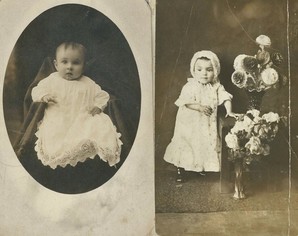An Essay about my Mother
"Edgewood." In Kate Farrell, Wisdom Has a Voice: Every Daughter's Memories of Mother, Unlimited Publishing, 2011, 149-155.
Gypsy and the Bird Man (in process)

What happens when you realize you know almost nothing about your heritage? These photos of my dad and mom as toddlers aroused my curiosity. What were their childhoods like in Cleveland? I knew mom's parents were Hungarian, but was ignorant concerning my dad's ethnicity. Thanks to genealogy searches, family papers, and more, I have composed a narrative that begins in the 1800s Central Europe, but I am about to completely rewrite the story. Sometimes this is necessary, no matter how appealing the draft!
It’s the story of Czech Bohemian and Hungarian immigrants assimilating into a new culture in Cleveland while simultaneously struggling to retain their old one. How a family moves from one world to another and weaves the common threads of disparate backgrounds into a new unified whole. Having finished what I thought was the book, I discovered a Jewish lineage, hidden purposely by part of the paternal family line in the early 1900s, and later found one in my maternal line as well.
As the photographs suggest, one branch was economically more successful than the other. The arc of this history demonstrates how ethnic and genetic patterns pass through generations in unexpected ways.
It’s the story of Czech Bohemian and Hungarian immigrants assimilating into a new culture in Cleveland while simultaneously struggling to retain their old one. How a family moves from one world to another and weaves the common threads of disparate backgrounds into a new unified whole. Having finished what I thought was the book, I discovered a Jewish lineage, hidden purposely by part of the paternal family line in the early 1900s, and later found one in my maternal line as well.
As the photographs suggest, one branch was economically more successful than the other. The arc of this history demonstrates how ethnic and genetic patterns pass through generations in unexpected ways.